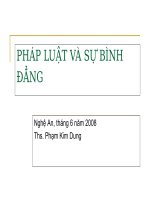Tập huấn Thay sách Anh 12 - 2008
Bạn đang xem bản rút gọn của tài liệu. Xem và tải ngay bản đầy đủ của tài liệu tại đây (116.69 KB, 33 trang )
TEACHING SPEAKING
Presented by
QUESTIONS FOR DISCUSSION
1. What kind of speaking should students do?
2. State the characteristics of a successful speaking
activity.
3. Point out the problems with speaking activities
and solutions to such problems.
QUESTIONS FOR DISCUSSION
4. How should you correct speaking?
5. List the activities/tasks often used in the three main
stages/phases of the lesson plan for teaching speaking
Follow-up activity
In groups, choose one speaking task in the textbook
(Tieng Anh 12 nang cao), then make a lesson plan for
teaching your 12-grade students.
KIND of SPEAKING
1. Speaking as controlled language
practice.
a. Repetition – class work
e.g. It’s nice to meet you.
b. Question and answer exchange- Pair
work or class work
e.g. invitations
KIND of SPEAKING
c. Combination of repetition and sentence making-
Class work
e.g. comparatives
d. Sentence making - Class work and individual
work
e.g. environment protection
Speaking tasks as controlled language practice
should be used in the practice stage
2. Speaking as free practice
Students are using any and all the language at their
command to perform some kind of oral task
Information gap – Pair work
e.g. Describe and draw
b. Survey – Group work
e.g. Sleep questionnaire
2. Speaking as free practice
c. Discussion – Group work
e.g. Single family versus extended family
d. Role play – Pair work
e.g. Interviewer and interviewee in a job
interview
Speaking tasks as free practice should be
used in the Production stage.
Top-down and bottom-up processing
Top-down processing
-
The speaker brings to the international communicative
act a set of pre-supposition about the situation, the
participants in the exchange, and the expected
outcome of the exchange.
-
The speaker bases on their background knowledge of
the sociolinguistics, rules of appropriacy and the focus
on intended message with respect to the listener’s
situation to make choices that form the spoken
product.
Top-down and bottom-up processing
Bottom-up processing
-
The speaker initiates the interaction with a
communicative intention. This is to be
realized through utterances .
-
The speaker makes use of his own language
knowledge, speaking skills, and
communication strategies to form the spoken
product (utterances).
The roles of the teacher
Prompter
- Teacher can help students and the
activity to progress by offering discrete
suggestions. - Students won’t feel
frustrated when coming to a dead end
of language or ideas if teacher’s help
doesn’t disrupt the discussion or forcing
them out of role.
The roles of the teacher
Participants
Teacher’s participation in discussion or role-plays will
help the activity long by prompting covertly,
introducing new information. Also, this will ensure
continuing student engagement and generally
maintain a creative atmosphere.
Teacher should not take over the classroom so
that students lose opportunities for speaking.
The roles of the teacher
Feedback provider
Teacher should avoid overcorrection.
Helpful and gentle correction may get
students out of difficult
misunderstanding and hesitations.
Characteristics of a successful
speaking activity
According to Ur (2002:120), the characteristics of a
speaking activity that make teachers judge it
“successful” are:
1. Much learner’s talk
2. Even Participation
3. High motivation
4. Acceptable level of language accuracy









